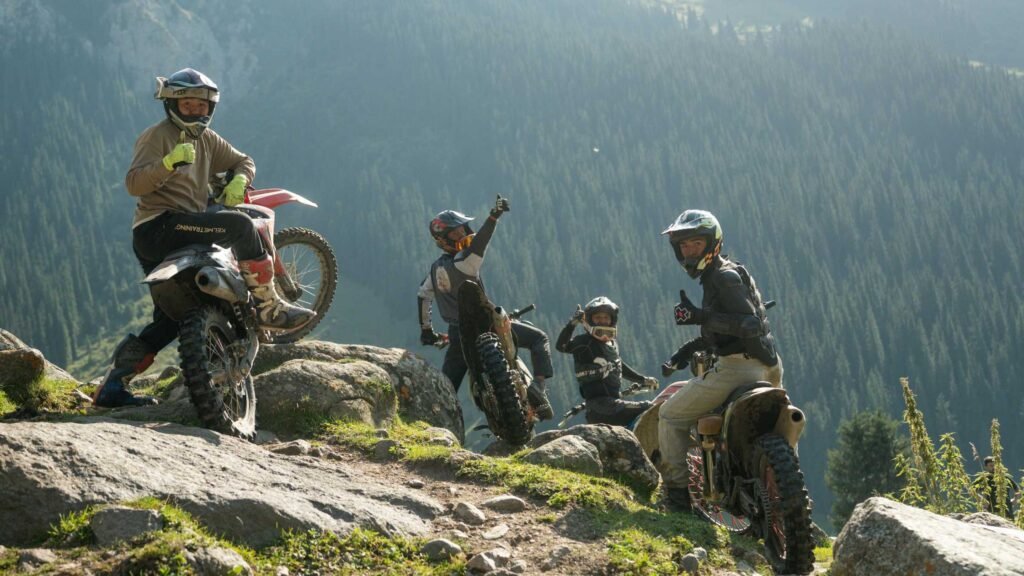If you do mountain biking 2 to 3 times a week, it will take around 4 to 6 weeks to get comfortable and confident. After that, you will start enjoying it more than you fear it.
However, if you ride only on weekends or skip too often, it can take 2 to 3 months easily. But you will get there.
I have seen people start in their 40s, 50s, even 60s — and they all got better just because they stayed consistent.
Also read: Starting Mountain Bike at 40: 10 Tips to Follow.
What “Getting Used To” Actually Means

When people ask this question, most of them don’t even know what “getting used to” truly means.
It doesn’t mean you’re jumping rocks or clearing technical trails.
It means your mind and body start adapting to the feel of the bike.
That includes:
- You stop overbraking or freezing on small descents.
- You handle turns and roots more smoothly.
- Your breathing becomes more controlled during climbs.
- You no longer fear falling on easy trails.
- You start enjoying the flow instead of fighting with your bike.
In the beginning, your body will ache — your hands, lower back, core, even your shoulders.
But after 2 to 3 weeks, your muscles will adjust, your brain will stop panicking, and you’ll start enjoying every ride more than before.
If you’re a complete beginner, also read: Mountain Biking Tips for Beginners.
The First 2 Weeks: Your Body Is Learning, Not Your Mind
When you start, your body doesn’t know what’s going on.
Your muscles will get confused because mountain biking is not like normal cycling — it involves balance, control, and stability.
So in your first week, ride slow.
Find easy, flat trails — even if they’re boring.
Just focus on your body position, how the bike feels when it turns, and how the brakes respond.
If you don’t know what trails to start on, you can use apps like Trailforks or AllTrails to find beginner MTB trails near you.
During your first few rides:
- Keep your eyes forward, not on your front wheel.
- Ride for 20–30 minutes, not hours.
- Stand up when you go over small bumps.
- Practice shifting gears smoothly.
You’ll probably get tired fast and feel sore, but it’s fine. It’s part of your body’s adaptation.
Just make sure to check your bike before every ride using this: Mountain Bike Pre-Ride Checklist.
Week 3 to Week 4: Builds Confidence

After about 2 weeks, you’ll notice something — your body starts remembering what to do.
- You’ll naturally start shifting gears before a climb.
- You’ll control your braking better.
- Your fear will start reducing.
During this (3rd week) stage, you can start riding on slightly tougher trails — not advanced, but ones with small climbs, roots, or light rocks.
Also, make sure your body stays fit. Even 15 to 20 minutes of core exercises will help a lot because your core controls balance on the bike.
You can learn some of the best ones here: Core Strength for Mountain Biking.
However, by the end of the first month, your body and brain will start syncing.
You will no longer panic when you see a small hill, and you’ll ride smoother.
If you’re still feeling your stamina is weak, check out this one — 9 Effective Ways to Build Stamina for Longer Mountain Bike Rides.
After One Month: You Start Flowing
By now, your muscle memory kicks in.
You will notice your body automatically stands when you hit a bump or you shift your weight back while descending.
These small things mean your body has started adapting.
At this stage, try to mix your rides — ride one day on a flat route, and another day on a slightly rocky or technical trail.
That’s how your brain learns to react differently to different terrains.
Also, start doing warm-up and cool-down exercises — they will help prevent fatigue and injuries. Read: Mountain Bike Warm-Up Exercises.
If your goal is to improve faster, include some interval rides — like riding hard for 30–60 seconds, then resting for 1–2 minutes, and repeating it.
That helps you handle tough climbs easily. You can read this: Mountain Bike Endurance Training.
2 to 3 Months: You’re Becoming a Real Rider
This is when you start feeling like mountain biking is a part of your life.
Your fear level will drop drastically, and you begin to crave more challenging trails.
You’ll start experimenting with things like small jumps, drops, and cornering techniques.
You’ll also notice your stamina has improved a lot than in the first week— you can now ride for longer hours without getting too tired.
If your goal is to improve climbing or endurance, do a few longer rides every week. Even one long ride per week helps.
At this point, you’ll know which type of pedal feels right — some prefer clipless pedals for power and control, while others stay with flat pedals for freedom.
If you’re confused, check this one: Clipless vs Flat Pedals: Which One Should You Really Choose?.
Also, don’t forget to maintain your bike after every few rides.
Lubricate the chain, check the brakes, and make sure your tires have proper pressure. Here’s a quick guide: Mountain Bike Chain Maintenance.
Why Some People Take Longer Than Others

Every human is built differently, right?
Therefore, some riders adapt within a month, while others take three or more.
That’s completely fine. Everyone learns differently.
Here are a few reasons why it might take longer for you:
- Fear of Falling: Most beginners ride with fear in mind. Fear slows progress. Try to fall small, learn fast, and move on.
- Inconsistency: Riding once every two weeks won’t build confidence.
- Fitness Level: If you’re not active otherwise, it’ll take longer.
- Wrong Trails: Starting directly on red or black trails instead of green ones kills confidence.
- Bike Setup Issues: A bad setup causes fatigue, pain, and frustration.
If you’re older or restarting fitness, it’s okay to take it slow. Read this one — What Is the Best Age to Start Mountain Biking?. You’ll see how many people begin later in life and still ride better than most.
Tips That Help You Adapt Faster
These are simple but effective if you really want to get used to biking faster:
- Ride with someone better than you. It pushes you automatically.
- Track your rides using an app like Strava — watching improvement keeps you motivated.
- Don’t compare yourself with others. Everyone learns differently.
- Practice cornering and braking intentionally once or twice a week.
- Try scenic trails occasionally; they keep you motivated and break boredom. Read: Scenic Mountain Bike Trails.
- Do proper recovery: You should do stretching or yoga, which will help a lot.
- Stay consistent: That’s the only secret to improvement.
If you ever get demotivated, take a short break, watch some MTB videos, or try a different trail — something new always resets motivation.
What You Will Feel After Getting Used To
After you’re used to mountain biking, you will notice these things:
- Your fear will almost disappear.
- You will handle rocks, roots, and corners without even thinking.
- You’ll climb with steady breathing.
- You will look ahead naturally instead of down.
- You’ll start doing skills without realizing it.
- You will love the feeling of every ride, no matter whether short or long.
That’s when you will know that your body and mind have synced perfectly with your bike.
From here, you will see real growth, like your stamina has improved, and you have learnt new skills. And, you can now ride longer while keeping your flow alive.
Conclusion
So, getting used to mountain biking is easy and won’t take years. If you’re riding at least 2 to 3 times a week, then within a month, you will feel that your body and mind have started adapting.
You will stop feeling stiff on descents, your braking will become smooth, your balance will be better, and you’ll start enjoying it rather than worrying about falling.
But if you’re skipping rides or riding once every two weeks, then you’re restarting every time. That’s what delays everything.
I’d say, just keep it simple — do small rides, even 30 minutes daily, check your bike before every ride (Mountain Bike Pre-Ride Checklist), and don’t ride scared.
The day you stop thinking “what if I fall,” that’s the day you’re used to mountain biking.
And from there, trust me, every single ride will become fun. You will feel proud of yourself for not quitting when it was tough in the beginning.
FAQs
Here are some questions and answers about getting used to mountain biking.
How long it really takes to get used to mountain biking?
If you’re consistent and ride 2–3 times a week, then within 4 to 6 weeks, your body and mind both will start adapting.
You won’t feel nervous anymore, your confidence grows, and you start feeling natural on trails.
But yes, if you’re only riding sometimes, it’ll take longer, maybe 2–3 months or more. Just ride regularly and you’ll see the difference.
I still feel nervous every time before riding a Mountain Bike
Yes, 100%. Every new biker feels that way, even I did in the beginning. Your brain always worries about balance and falling, but after 10–15 rides, that fear starts disappearing automatically.
For now, ride on easy trails — you can find some Family-Friendly Mountain Bike Trails or local beginner trails and stay consistent.
I get tired quickly when ride a Mountain Bike
That happens with every beginner because your legs and core aren’t used to it yet.
Just do small, consistent rides, and if you want to improve faster, do a few workouts like squats, planks, and interval training.
I’ve shared a full guide here: 9 Effective Ways to Build Stamina for Longer Mountain Bike Rides. Within a few weeks, you’ll notice a big difference.
How do I stop feeling pain in my hands and legs after riding?
It’s mostly because your body isn’t used to the riding posture yet, or your bike setup isn’t correct. Check your seat height and handlebar position.
Do a short warm-up before rides and light stretching after. It’ll reduce stiffness. You can read this too: Mountain Bike Warm-Up Exercises.
What if I’m older, will it take me longer to get used to it?
Not really, maybe just a little slower at the start, but you’ll still get there. I’ve written a full article for people starting at that age — Starting Mountain Bike at 40: 10 Tips to Follow.
You’ll see that age doesn’t matter as long as you ride regularly and stay active.

Ali is the founder of Mountain Bike Insider and an passionate rider with years of hands-on experience in mountain biking. From testing gear to exploring trails, Ali writes based on real riding knowledge to help others make smart, safe, and enjoyable biking choices. Every guide is built on research, personal use, and a passion for the sport.







